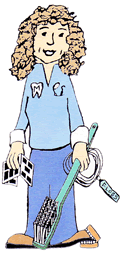1960’s – You don’t have to floss all your teeth, – – just the ones you want to keep!
1970’s – Place ½ of the toothbrush bristles on the gums and the other ½ on the teeth, press firmly into the junction and squeegee the handle of the brush, not allowing the bristle tips to move much.
 1980’s – On a weekend, (when you are sitting at home watching an old classic movie!), dry brush your gums and teeth for 10 minutes; (they’ll feel like they do right after I have cleaned them!!)That means no water and no toothpaste.
1980’s – On a weekend, (when you are sitting at home watching an old classic movie!), dry brush your gums and teeth for 10 minutes; (they’ll feel like they do right after I have cleaned them!!)That means no water and no toothpaste.
1990’s – As we age, (40-ish), our teeth get more brittle and break easier, so eat thoughtfully. It’s that one super hard almond in a handful that will break a tooth. The first 3-4 chews of each bite should be done with care.
2000’s – Wrap the floss around the “corners” of the teeth and then scrape the tooth up and down, going beneath the gum as far as you can comfortably. 90 percent of our decay is found in-between the teeth where the toothbrush is obsolete. Flossing may prevent heart attack and stroke!!
2010’s – As we mature (50’s and 60’s), we are in the second most likely time in our lives to get decay.
This is because:
1. We may have gums that have receded showing our “soft” roots, and we are more likely to catch food between our teeth, which continually feeds our bacteria which make acid!!
2. We may be on medications that dry out our saliva; (saliva dilutes bacterial acids, without saliva-our acids get concentrated!!)
3. Our habits may include putting hidden enemies in our hot tea and coffee, like cream, sugar or substitutes, or honey, all of which are devastating to our roots which can decay at a much faster rate than our enamel did in our teenage years.
4. Our plaque is stickier and we need to brush and floss more often than in the past. (I hate that!!)
TODAY – Be with your teeth when you clean them, don’t be multitasking-if you are thinking about what you have to do this day, you’ll miss areas.
1. If you gag easily, concentrate on doing a better job in the evening when the gag reflex is not so strong.
2. Watch your tongue, it may try to “protect” you from yourself and block the brush from cleaning thoroughly!
3. Toothpaste, use the size of a pea; baking soda and silica are abrasive; peroxide can pit the tooth surface causing staining and weakness.
4. Floss in-between the teeth first, and then the fluoride in the toothpaste can actually help where most cavities are found.
5. Manual brushes and electric brushes use different techniques to remove plaque. Make sure you don’t confuse them, or you can damage root surfaces.
6. Chewing Gum with XYLITOL can recalcify your teeth and help prevent cavities. (It should be third on the list of ingredients).
